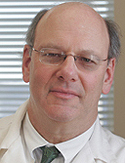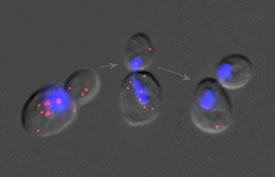
mRNA Research
Built-In 'Self-Destruct Timer' Causes Ultimate Death of Messenger RNA in Cells
December 22, 2011 — (BRONX, NY) — Researchers at Albert Einstein College of Medicine of Yeshiva University have discovered the first known mechanism by which cells control the survival of messenger RNA (mRNA) — arguably biology’s most important molecule. The findings pertain to mRNAs that help regulate cell division and could therefore have implications for reversing cancer’s out-of-control cell division. The research is described in today’s online edition of the journal Cell.

Robert Singer, Ph.D.“The fate of the mRNA molecules we studied resembles a Greek tragedy,” said the study’s senior author, Robert Singer, Ph.D., co-director of the Gruss Lipper Biophotonics Center and professor and co-chair of anatomy and structural biology at Einstein. “Their lifespans are determined at the moment of their birth.” The study was carried out in yeast cells using advanced microscope technology developed previously by Dr. Singer that has allowed scientists, for the first time, to observe single molecules in single cells in real time.
Directions for making proteins are encoded in the DNA sequences of genes, which reside on chromosomes in the nucleus of each cell. But for proteins to be made, a gene’s DNA code must be copied, or transcribed, onto mRNA molecules, which migrate from the nucleus and into the cytoplasm where the cell’s protein-making machinery is located. For as long as it exists, an mRNA molecule can act as a template for making copies of a protein. So scientists have long suspected that cells must have ways for degrading mRNAs when, for example, a protein starts accumulating to harmful levels. “The cell somehow decides to destroy its mRNA on cue, but nobody knew how this happens,” said Dr. Singer.

Messenger RNA molecules (in red) during cell division.In their search for such a mechanism, Dr. Singer and his colleagues focused on two genes, SWI5 and CLB2, which code for proteins that regulate the cell cycle—the complex series of steps during which a cell divides, first duplicating its genetic material and then distributing it evenly to two daughter cells. To properly choreograph the cell cycle, the levels of the proteins encoded by the SWI5 and CLB2 genes must be exquisitely controlled—suggesting that the mRNAs made from these genes would be prime candidates for purposeful degradation. Remarkably, the researchers found that these mRNAs are, in effect, born with molecular “self-destruct timers” that ultimately destroy them.
When genes are transcribed, a part of the gene called the promoter region has the job of switching on the gene so that DNA will be copied into mRNA. The Einstein scientists found that the promoter regions of the SWI5 and CLB2 genes do something else as well: they recruit a protein called Dbf2p, which jumps onto mRNA molecules as they’re being synthesized.
These mRNAs—transcribed from the SWI5 and CLB2 genes and bearing the Dbf2p protein—make their journey from the nucleus into the cytoplasm. Here a protein called Dbf20p joins Dbf2p aboard the mRNA molecules—and the two proteins together call for the molecules’ precipitous decay.
“The fate of the mRNA molecules we studied resembles a Greek tragedy. Their life spans are determined at the moment of their birth.”
-- Robert Singer, Ph.D.
“Our findings indicate that genes making proteins whose levels must be carefully controlled contain promoter regions that sentence their mRNA molecules to death even as the mRNA is being born,” said Dr. Singer. “The promoter regions do that by ‘marking’ the newly made mRNA with the protein Dbf2p—the common factor between mRNA synthesis and its ultimate decay. Dbf2p stays attached to the mRNA from its birth and then, responding to a signal indicating that no more protein should be made, orders mRNA’s destruction.”
While these observations pertain to yeast cells, Dr. Singer said he is confident that the process governing mRNA decay in humans “will prove to be very similar” and could be relevant for combating cancer. “Once you gain insight into the mechanisms controlling the cell cycle and cell division,” he noted, “you can propose targeted therapies for regulating the uncontrolled cell division that characterizes cancer.”
The paper is titled “Single-molecule mRNA decay measurements reveal promoter-regulated mRNA stability in yeast.” Other scientists involved in the study were lead author Tatjana Trcek (who did this work at Einstein as part of her thesis and is now a postdoctoral student at New York University), Daniel Larson, Ph.D. (now at the National Cancer Institute), postdoctoral fellow Alberto Moldón, Ph.D., and Charles Query, M.D., Ph.D., professor of cell biology at Einstein. This research was supported by the National Institute of General Medical Sciences of the National Institutes of Health.
Other Top Stories
9/11 World Trade Center Exposure Linked to Heart Disease Among NYC Firefighters
On Becoming a Physician: New Einstein Students Receive White Coats and Stethoscopes
Novel Therapy for Acute Migraine Shows Promise in Phase 3 Clinical Trial
First Complete Wiring Diagram of an Animal's Nervous System
Multimillion Dollar NIH Grant to Help Reduce Opioid Use & Get Care to People Who Need It
NIH Grant Funds $23 Million Study of Diseases Affecting People Living with HIV
New TAILORx Data Guides Adjuvant Therapy in Younger Breast Cancer Patients
Einstein Celebrates Its 61st Commencement
Bolstering Biopsies: Testing Patients' Individual Cells to Guide Treatment



